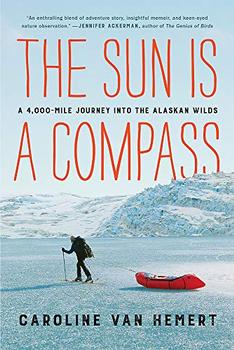Summary | Excerpt | Reviews | Beyond the Book | Read-Alikes | Genres & Themes | Author Bio

A 4,000-Mile Journey into the Alaskan Wilds
by Caroline Van HemertThis article relates to The Sun Is a Compass
 Caroline Van Hemert's memoir, The Sun is a Compass, chronicles a 4000-mile journey that concludes in northwest Alaska in the city of Kotzebue.
Caroline Van Hemert's memoir, The Sun is a Compass, chronicles a 4000-mile journey that concludes in northwest Alaska in the city of Kotzebue.
Kotzebue is located on a three-mile-long sand spit at the end of the Baldwin Peninsula, where the Noatak, Kobuk and Selawik rivers converge. Although it was named after Otto von Kotzebue (1787-1846), a German explorer and fur trader in the employ of the Russian Empire, the area was a central trading hub for the native population for at least 600 years before it was "discovered." The indigenous name for the area is Kikiktagruk, which means "almost an island." Trade expanded as Russian fur agents and missionaries arrived, and whalers and gold miners further supplemented the population.
Kotzebue officially became a part of the United States when Alaska was purchased from Russia in 1867. A post office was established there in 1899, and in 1900 the population was about 200. The city was incorporated in 1958, and when Alaska achieved statehood in 1959, Kotzebue had grown to 623 residents.
Currently the population stands at over 3,200, 70% of whom are Native Alaskan, known as Inupiats. 54% of the residents are male, with a median age of 29 years. Household incomes are high compared to the rest of Alaska, with an average of $87,564 annually (vs. $76,440 for Alaska as a whole). This is likely in part due to the high-paying jobs at the nearby zinc mine, more on this below. The nearest large city is Anchorage, over 500 miles away.
Tourism isn't a large part of Kotzebue's economy, but it does bring in some revenue. The summer climate is relatively temperate, with highs in the 50 to 70°F range, plus the sun doesn't set from June 3 to July 9. This combination attracts kayakers, fishermen, backpackers and those interested in wildlife viewing. The area is home to the largest caribou herd in Alaska, comprised of approximately 259,000 animals. Hunting is permitted, but is generally limited to subsistence purposes only. Although temperatures can get down to -50°F during the winter months, many vacationing skiers and mushers are undeterred, visiting Kotzebue to pursue their hobbies. The daily lows are below freezing 250 days of the year.
Unfortunately, Kotzebue has recently become known as one of the most toxic cities in the United States. The Red Dog Mine, located 80 miles north of the city, is the world's largest producer of zinc (and also the highest paying employer in Kotzebue). According to the EPA, it creates approximately 756 million pounds of toxic waste per year, more than any other operation in the country. There is no conclusive evidence as to whether or not this toxicity is affecting the health of Kotzebue's citizens.
Kotzebue, Alaska, courtesy of Lavonne's Fish Camp
Filed under Places, Cultures & Identities
![]() This "beyond the book article" relates to The Sun Is a Compass. It originally ran in April 2019 and has been updated for the
February 2020 paperback edition.
Go to magazine.
This "beyond the book article" relates to The Sun Is a Compass. It originally ran in April 2019 and has been updated for the
February 2020 paperback edition.
Go to magazine.
Your guide toexceptional books
BookBrowse seeks out and recommends the best in contemporary fiction and nonfiction—books that not only engage and entertain but also deepen our understanding of ourselves and the world around us.